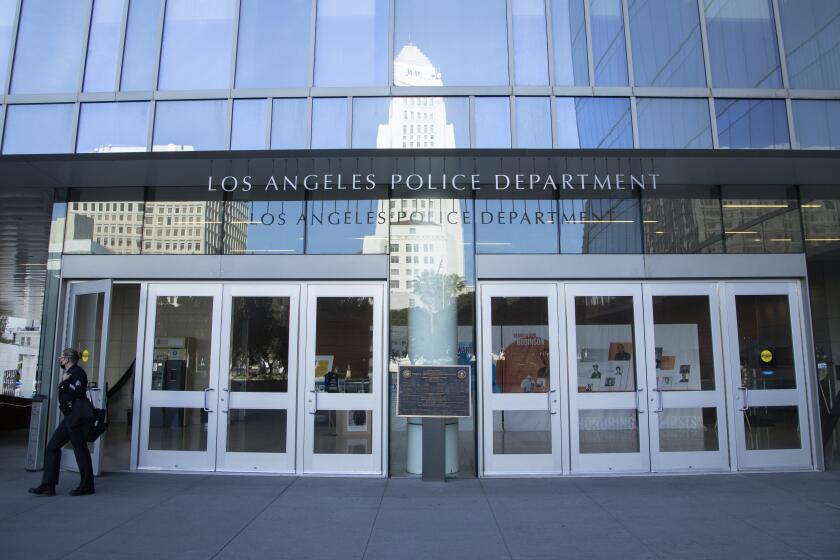Imagine Life Without a Future : Economic restructuing has eliminated jobs for black youth, but their ‘empowerment’ must be race-neutral to succeed.
Even before the smoke cleared after what may be the worst urban riot in America’s tortured racial history, Los Angeles Mayor Tom Bradley called for a program of “economic empowerment” for black men from ages 16 to 25. Many believe it was their rage that set Los Angeles ablaze, and that others like them are the volatile tinder for the social explosion waiting to happen in America’s major cities.
Where does the rage come from? If, as is widely perceived, these angry young men not only torched Los Angeles, but are indeed the vanguard of urban violence, drug-pushing and crime, then why? And what is the response?
To answer these questions, it is necessary to look at how the black community in America has been transformed during the 30 years between Martin Luther King’s crusade for racial justice and Rodney King’s brutal beating.
The most fundamental change is that many poor black neighborhoods today are no longer organized around work. A majority of adults in inner-city ghettos are either unemployed or have dropped out of the labor force. Consequently, their everyday lives are divorced from the rhythm and reality of the American mainstream.
The figures are stunning. I will take Chicago as the case in point, but the same holds roughly true across the nation.
In 1950, in the three poorest black neighborhoods of Chicago’s south side, there were 70 employed men for every 100 women aged 16 and over. That was close to the citywide figure of 74 working men to every 100 women. By 1980, that figure for Chicago’s poorest black communities had plummeted to an average of 23 working men for every 100 women inhabitants.
Thirty and 40 years ago, the overwhelming majority of black males were working. Most of them were poor, but they held regular jobs around which their daily family life was organized. There was much greater class integration in the black community. Although they may have lived on different streets, blacks of all classes lived in the same neighborhood. Their kids went to the same schools and played in the same parks.
Two factors primarily account for the sharp decline in the social organization of inner-city neighborhoods.
First, is the out-migration of many higher-income families. Today, of the 29 million American blacks, roughly 20% are in the professional middle class, with another 15% in non-professional white-collar positions. About 33% are working class but vulnerable to job loss through economic restructuring. The remaining 32% live in poverty, about half of whom are fully destitute.
It would be a serious mistake, therefore, to view the African-American community as a monolithic socioeconomic group. Indeed, there is clear evidence of a widening gap between the haves and the have-nots. In 1988, the highest fifth of black families secured a record 49% of total black income.
The upward mobility for the black middle-class also largely meant outward mobility from the ghetto, leaving the poor more isolated from conventional role models. More important, it removed an important social buffer that used to cushion the effects or deflect the full impact of increased and prolonged joblessness.
Second, the services and information revolution in the economy over the last three decades has enforced a more intractable poverty on those isolated in the ghetto, leading to what has been called “the dual city.”
At the top of the dual city are the most educated and affluent white elites of American life--investment bankers, lawyers, doctors and corporate managers guiding the growth of a dynamic, internationalized, knowledge-intensive economy.
At the bottom are the poorest and least educated blacks and Latinos, chasing vanishing entry-level jobs of a fading industrial era.
By and large, the better educated middle class of all races has fled to the suburban rings of growth, leaving most of America’s central cities as the place where only the rich and the destitute dwell.
Although these processes have had an adverse effect on all poor minorities, they have been especially devastating to the lower-class black male. Thirty years ago, when black men looked for work, employers were concerned about whether they had strong backs because they would be working in a factory or doing heavy lifting and labor. The work may have been hard, but they were hired.
Now, economic restructuring has broken the figurative back of the black working class. As late as 1974, 48% of all black males aged 20 to 24 were working as semi-skilled machine operators or in craft positions that paid enough for a young man to support himself and his family. By 1986, only 25% of that group of black males worked in such jobs, while the others were forced to take the most low-paying positions or go unemployed.
In his time, Martin Luther King could still have a dream. These kids can’t even imagine a future.
All too many young men in the black community today have responded to these declining opportunities by resorting to crime, drugs and violence. This in turn has fed the image of young black men as dangerous. So, when looking for work in competition with immigrants, women or whites, employers prefer not to hire “trouble.”
There is no doubt in my mind that the downward cycle of declining opportunities and criminality for young black men has exacerbated racism in America. For the white cops who beat him and the jury that acquitted them, Rodney King--a high-school dropout with a criminal record--apparently fit the “trouble” profile. The cops had incorrectly assumed the worst, that King was on PCP. And their defense that he was potentially violent persuaded the white suburban jurors that police were justified in their actions.
Ethnographer Terry Williams even argues that, in the absence of opportunity, an alternative subculture has emerged, a kind of lost generation of school drop-outs involved with drugs and crime who refuse to be part of the system because they feel the system has rejected them.
The kids who tried to burn down L.A. last week were surely drawn from the ranks of that city’s lost generation. To be sure, these young men are far from blame for not taking personal responsibility. But the magnitude of Los Angeles’ social quake and the sheer number of black youth caught in a hopeless situation make it clear that the problem is systemic, not personal.
What can be done? I do not know what kind of “economic empowerment” program Mayor Bradley has in mind. But, lest the Republican years of neglect be granted a new lease on our future, those of us who sincerely want to address the present urban catastrophe should not make the same political mistakes that contributed to the majoritarian backlash against many Great Society programs.
It is critical that any economic empowerment program for black youth be embedded in broader, “race-neutral” policies that draw the support of all segments of the population, not just minorities.
Such policies would include employment programs that match skills with post-industrial jobs, public-school reform and comprehensive health care. Although a politically viable program for social justice will help all Americans, it would disproportionately benefit the most disadvantaged. In the face of America’s unraveling social contract, it would also help to bring the races together, not drive them farther apart.
More to Read
Start your day right
Sign up for Essential California for news, features and recommendations from the L.A. Times and beyond in your inbox six days a week.
You may occasionally receive promotional content from the Los Angeles Times.






